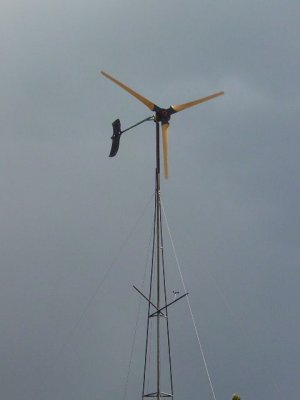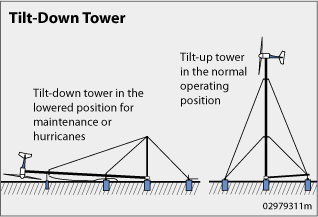small wind electric system tower

Small wind turbine and tower.

Here are two illustrations of a tilt-down wind turbine tower. Four wires extend from the tower, which looks like a pole. Two wires are attached near the top, and the other two are attached a little below the middle of the tower. The first illustration shows the tower tilted down, horizontally. The wind turbine is perpendicular to the ground, touching it, with its tail pointing to the sky. The second illustration shows a wind turbine tower in the upright position, vertical from the ground. All wires are shown taut. At the back of the turbine, a thin pole is shown extending from the tower to two of the wires.
Because wind speeds increase with height, a small wind turbine is mounted on a tower. In general, the higher the tower, the more power the wind system can produce. The tower also raises the turbine above the air turbulence that can exist close to the ground because of obstructions such as hills, buildings, and trees.
Tower height
Relatively small investments in increased tower height can yield very high rates of return in power production. For instance, to raise a 10-kilowatt generator from a 60-foot tower height to a 100-foot tower involves a 10% increase in overall system cost, but it can produce 25% more power.
The estimated annual energy output and turbine size you'll need can help determine the best tower height.
Types of towers
Most turbine manufacturers provide wind energy system packages that include towers. There are two basic types of towers: self-supporting (free-standing) and guyed. There are also tilt-down versions of guyed towers.
Most home wind power systems use a guyed tower, which are the least expensive. Guyed towers can consist of these components:
Guyed towers are easier to install than self-supporting towers. However, because the guy radius must be one-half to three-quarters of the tower height, guyed towers require enough space to accommodate them.
While tilt-down towers are more expensive, they offer the consumer an easy way to perform maintenance on smaller light-weight turbines, usually 10 kilowatt or less. Tilt-down towers can also be lowered to the ground during hazardous weather such as hurricanes. Aluminum towers are prone to cracking and should be avoided.
Installation or mounting
A general rule of thumb is to install a small wind turbine on a tower with the bottom of the rotor blades at least 30 feet (9 meters) above any obstacle that is within 300 feet (90 meters) of the tower.
Mounting small wind turbines on rooftops is not recommended. All wind turbines vibrate and transmit the vibration to the structure on which they are mounted. This vibration can lead to noise and structural problems with the building, and mounting on the rooftop can expose the turbine to excessive turbulence that can shorten its life.
